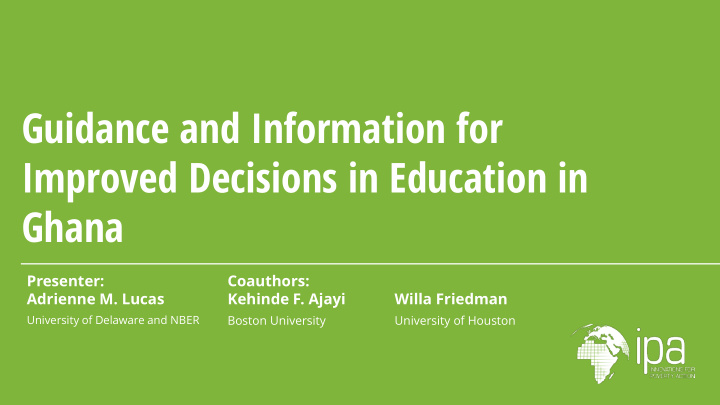



Guidance and Information for Improved Decisions in Education in Ghana Presenter: Coauthors: Adrienne M. Lucas Kehinde F. Ajayi Willa Friedman University of Delaware and NBER Boston University University of Houston
Guidance and Information for Improved Decisions in Education in Ghana – GUIIDE Outline Motivation • Designing GUIIDE • Evaluating GUIIDE • Preliminary Results •
Secondary School Choice Process in Ghana A basic overview Each student 1. Submits ranked list of up to four Senior High Schools 2. Takes the Basic Education Certification Exam (BECE) 3. Is admitted to at most one school based on BECE score and ranked list
Students Lack Information Students lack information about SHS quality leading to… • 40% of students switch to a school different than their official placement • Students arrive after the first term, are not well matched with the school, eventually drop out • Many students attend SHS but fail the WASSCE (certification exam) • New and high performing schools are undersubscribed Can information lead to more efficient use of existing resources?
Designing GUIIDE
How can we help students have better secondary school outcomes? We asked • Students • Parents • Teachers • Head Teachers • Government Partners The result: Guidance and Information for Improved Decisions in Education (GUIIDE)
What do students want to know? Most important school characteristics when choosing where to apply to secondary school
Who helps students choose? Students’ most helpful decision maker
GUIIDE • Booklet: • Application strategies • Worksheet to estimate BECE scores • Historical admissions criteria and WASSCE outcomes for each SHS • Video that dramatizes the admissions process • Question and answer session with trained enumerator
GUIIDE Coversheet Making careful choices is the best way to have a good secondary school experience Many students choose schools they do not know much about and are then dissatisfied with their placement How to make good secondary school choices: 1. Think about what is important to you and your family 2. Think about your likely raw BECE score (out of 600) 3. Pick schools you would actually like to attend
GUIIDE Worksheet on Raw BECE Scores
GUIIDE School Profiles
GUIIDE The Video
Evaluating GUIIDE
Evaluating GUIIDE Give students Guardians Students make Better and guardians ? more more informed ? ? secondary information involved in decisions about school about secondary choice secondary outcomes schools decision school
Evaluating GUIIDE Give students Guardians Students make Better and guardians ? more more informed ? ? secondary information involved in decisions about school about secondary choice secondary outcomes schools decision school
Evaluating GUIIDE • Does it improve outcomes? • Is it cost-effective? • Can it be improved?
Evaluating GUIIDE 900 Junior High Schools in Ashanti region Randomly assigned to one of three groups: Information to students Comparison group: no Information to students and parents information
Data Sources Use this … To measure … Guardian 5,272 guardians from Guardians’ involvement in and knowledge 433 JHS about secondary school choice process survey Triangulate multiple Student survey 13,034 students from Students’ knowledge about secondary 450 JHS school choice process sources of Students’ aspirations for university and data to careers evaluate the effects of Administrative Approximately 43,000 Students’ enrollment in and completion GUIIDE students from 900 JHS of SHS data The quality of SHS that students’ attend Students’ performance on WASSCE Students’ likelihood of going to university
Preliminary Results
Information Reached Guardians Guardians in both • 35% information groups were 31% 29% 30% more likely to have seen a Guardians Who Saw Information booklet with information 25% about the secondary school admissions 20% 19% process. 14% 15% Guardians in the • information to students 10% and parents group were 5% 4% 5% more likely to have seen a video with this 0% information. Seen booklet Seen video Information to students and guardians Information to students Comparison group mean
Information Increased Guardians’ Involvement 60% 55% 50% 47% 47% 40% 40% Percent of Guardians 31% 29% 30% 25% 24% 20% 10% 0% Guardian provides help In Guardian has final vote Guardian is sole decision Guardian knows order of selection maker choices Information to students and guardians Comparison group mean
Lower Likelihood of University Aspirations for Women Lower reported ambition 80% among female guardians 69% 70% (regardless of the gender 57% 60% of the student) 52% 50% Percent 40% 40% Lower reported ambition 30% and on behalf of female 20% students (regardless of 10% the gender of the 0% guardian) Male Guardian Female Guardian Male Student Female Student
Takeaways • Targeting guardians directly with information increases their involvement in the school choice process • Does this improve student outcomes? • Is it cost effective? • Could the information be more useful?
Recommend
More recommend